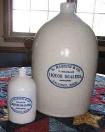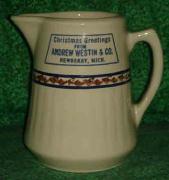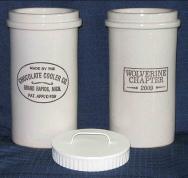|
Wolverine Chapter |
|
Red Wing Collectors Society |


|
Chapter Commemoratives |
|
2007 |
|
2008 |
|
2009 |
|
2006 |
|
While advertising on a Red Wing jug is not unusual, the “bullet beehive” is believed to be unique to the copper country of Michigan’s Upper Peninsula. This jug, which was made in the early 1900’s specifically for G. Martini & Co. of Calumet, is not your typical beehive. The top, more elongated and pointed than the beehive most of us are familiar with, takes on the appearance of a bullet, hence the name. Entries in the Potteries Ledger refer to a “special shape”. Undoubtedly these refer to the “bullet beehive”. 35 of these commemoratives were produced by W.A. Painter Pottery Works. |
|
The business that Andrew Westin purchased from J.A. Shattuck in 1912 was the typical general store of the time. Located in Newberry, in Michigan’s beautiful Upper Peninsula, the store motto: “Everything to eat and wear” was certainly true. One could literally purchase everything from soup to nuts (edible and hardware) in just one stop. A 1932advertisement shows 2 large cans of I.G.A. peaches selling for $.42 while 2 packages of Ivory Snow would set you back $.25. Customer loyalty was important and Westin rewarded his patrons with sales and Red Wing products that were most likely a gift with purchase. Among these were this pitcher. 24 of these commemoratives were produced by Artists in the Park. |
|
Abraham H. Eddy began business as a grocer in Sault Ste. Marie, MI, in 1898. In 1900 he added a partner and the business was known as Eddy & Reynolds until 1909 when the partnership was dissolved. In 1913 his wife, Sarah J. Eddy, joined him in the grocery business which was listed in the City Directories for Sault Ste. Marie as Grocers offering Fresh Smoked and Salt Meats, Bakery Goods and Dairy Products. Retail fruits were added in 1915 which led to the addition of wholesale fruit in 1921. 26 of these commemoratives were produced by Artists in the Park. |





|
The Chocolate Cooler Company was just one of the many names used in business ventures begun in the late 1800’s by Phillip Fritz, Grand Rapids, MI. “At one time, the Grand Rapids Cabinet Company ...was known as the world’s largest manufacturer of Ice Cream Coolers.” “Fully customized ice cream parlors were developed, manufactured...and shipped out for installation. One of the largest accounts was the Bridgeman Company in Minneapolis.” The Red Wing Union Stoneware Company was chosen to provide the stoneware jars that kept the ice cream cold. The first entry in the Potteries Ledger for “100 Small Jars stamped Chocolate Cooler Co. Grad (sic) Rapids, Mich.” is dated 4/10/1911. Other orders for jars of various sizes can also be found in the ledger. W. A. Painter Pottery Works produced 25 regular and two special commemoratives. |


|
2010 |
|
All sports have their classic rivalries and their prized trophies. In collegiate football, the “Little Brown Jug” is awarded to the winner of the classic battle between two Big Ten teams, the University of Michigan Wolverines and the University of Minnesota Golden Gophers. While there are differences in almost every version of the origin of this stoneware jug, there is little doubt that it was a Red Wing product. As early as 1903, the rivalry between the two teams was such that, upon arriving in Minnesota, Michigan’s Coach Yost feared his team might be given tainted water by the opposition. He sent an assistant to purchase a new water jug. This white, five gallon jug reportedly cost 30 cents. The game was intense and when Minnesota scored late in the second half to tie 6 - 6, pandemonium broke out. The game ended as a tie. Upon leaving, the Michigan team forgot the water jug. Coach Yost asked that the jug be returned and was told “if you want it you’ll have to win it” . Thus was born the battle for the “Little Brown Jug”. The two teams did not play each other again until 1909 when Michigan won and was given the jug. Ten years passed until the rivalry was renewed. Eventually a brown glaze and the “M” of each team were added. As a team won, the score of the game was added to note the victor of the battle. To date, the records are: University of Michigan 66—22—3 University of Minnesota 22—66—3. Original Jug |
